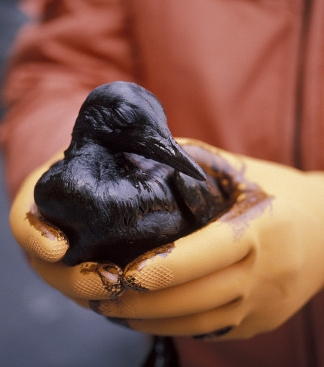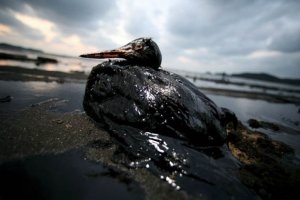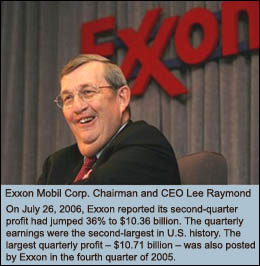
ASSOCIATED PRESS: The Supreme Court has struck down a Louisiana law that allows the execution of people convicted of a raping a child.
WASHINGTON POST: Exxon Mobil, the giant oil corporation appearing before the Supreme Court yesterday, had earned a profit of nearly $40 billion in 2006, the largest ever reported by a U.S. company — but that’s not what bothered Roberts. What bothered the chief justice was that Exxon was being ordered to pay $2.5 billion — roughly three weeks’ worth of profits — for destroying a long swath of the Alaska coastline in the largest oil spill in American history.
Alaska coastline in the largest oil spill in American history.
“So what can a corporation do to protect itself against punitive-damages awards such as this?” Roberts asked in court.
The lawyer arguing for the Alaska fishermen affected by the spill, Jeffrey Fisher, had an idea. “Well,” he said, “it can hire fit and competent people.”
The rare sound of laughter rippled through the august chamber. The chief justice did not look amused.
Nineteen years after the Valdez ran aground in Prince William Sound and spilled 11 million gallons of oil, the 32,000 plaintiffs — mostly fishermen, cannery workers and Native Alaskans — have received no punitive damages from Exxon. A jury awarded them $5 billion in punitive damages — a record level, for a record disaster — and an appeals court cut that in half. Now, the Supreme Court seems inclined to deal another insult to the victims (as many as a fifth of whom have already died) by cutting the award further. MORE
ASSOCIATED PRESS: Exxon Mobil Corp. posted record profits for ANY U.S. company on Monday — $10.71 billion for the fourth quarter and $36.13 billion for the year — as the world’s biggest publicly traded oil company benefited from high oil and natural-gas prices and solid demand for refined products. The results exceeded Wall Street expectations and Exxon shares rose more than 3 percent in afternoon trading. The company’s earnings amounted to $1.71 per share for the October-December quarter, up 27 percent from $8.42 billion, or $1.30 per share, in the year ago quarter. The result topped the then-record quarterly profit of $9.92 billion Exxon posted in the third quarter of 2005. MORE
WIKIPEDIA: The Exxon Valdez Oil Spill, which occurred on 24 March 1989, is considered one of the most devastating man-made environmental disasters ever to occur at sea. As significant as the Exxon Valdez spill was, it ranks well down on the list of the world’s largest oil spills in terms of volume released.[1] However, Prince William Sound’s remote location (accessible only by helicopter and boat) made government and industry response efforts difficult and severely taxed existing plans for response. The region was a habitat for salmon, sea otters, seals, sea birds and the great white shark. The vessel spilled 10.8 million gallons of Prudhoe Bay crude oil into the sea.
difficult and severely taxed existing plans for response. The region was a habitat for salmon, sea otters, seals, sea birds and the great white shark. The vessel spilled 10.8 million gallons of Prudhoe Bay crude oil into the sea.
Both the long and short-term effects of the oil spill have been studied comprehensively. Thousands of animals diedseabirds, 2,800–5,000 sea otters, approximately 12 river otters, 300 harbour seals, 250 bald eagles, and 22 orcas, as well as the destruction of billions of salmon and herring eggs. immediately; the best estimates include 250,000–500,000 Almost 15 years after the spill, a team of scientists at the University of North Carolina found that the effects are lasting far longer than expected.[17] The team estimates some shoreline habitats may take up to 30 years to recover. MORE
 SEATTLE INTELLIGENCER: “I advertised my services at Fishermen’s Terminal. At first, fishing was something to do in the summer. But then I found I was pretty good at it.” So McLenaghan worked his way up the ranks. In two years, he was running his own gillnetter. At 24, he skippered a salmon and herring purse seiner. In 1989, he’d made enough money to go all in: $1 million in savings and loans — everything he had — to buy a 50-foot boat and licenses for Prince William Sound herring, Cook Inlet herring and Chignik salmon.
SEATTLE INTELLIGENCER: “I advertised my services at Fishermen’s Terminal. At first, fishing was something to do in the summer. But then I found I was pretty good at it.” So McLenaghan worked his way up the ranks. In two years, he was running his own gillnetter. At 24, he skippered a salmon and herring purse seiner. In 1989, he’d made enough money to go all in: $1 million in savings and loans — everything he had — to buy a 50-foot boat and licenses for Prince William Sound herring, Cook Inlet herring and Chignik salmon.
Two months later, at 11 p.m. on March 23, 1989, Capt. Joseph Hazelwood retired to his stateroom and left third-mate Gregory Cousins in charge of the tanker Exxon Valdez as it sailed toward Washington.
third-mate Gregory Cousins in charge of the tanker Exxon Valdez as it sailed toward Washington.
McLenaghan hadn’t yet fished a single day on his new licenses or boat. “I had just dumped all of my money into it. You know how it goes, how you buy a business and that first year is pivotal.
“Once the oil spill hit, it zeroed me out.” So McLenaghan started selling stuff. So did every other fisherman, from Seattle to Alaska, who depended on the closed fisheries. And it was not, to put it plainly, a seller’s market. His daughter was 3 at the time.
Exxon, for its part, also appears to have recovered. In recent years, the company has set records as the most profitable in world history, netting nearly $40 billion in 2006 alone. MORE

 RELATED:
RELATED: